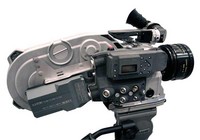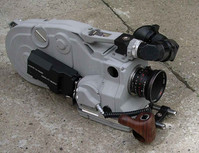Aaton Penelope

Hos Aaton i Grenoble arbetas det för fullt med att färdigställa deras senaste 35 mm kamera, Penelope, som kommer att bli en tyst och lätt kamera med snabbväxlingsmagasin.
Här kan du ladda hem två korta filmsekvenser.
…
The Aaton Penelope
presented by Aaton

Here is a photo of the Aaton Penelope prototype. This is the only auto-silenced 35 mm camera with instantaneous magazines that was ever built and it is also the first 35 mm camera that definitively abandons Dickson/Edison’s 4-perf film. The film-pulling mechanism only works with 3-perf for lovers of 1.66:1, 1.78:1, 1.85:1 formats or with 2-perf for Scope addicts.
The few “cinematographers” who have had a chance to play with it appreciated the way it aims and more especially its adjustments for wide heads or for left-eyed operators. They also commented on the use of a new polycarbonate/aluminium alloy that sound-proofs the film-winding mechanism and is so light that its can be used from the shoulder, under the arm or between the legs without being tiring, depending on the height of the film shot. Another specificity: a second on-board Li-Ion 80 W battery powers the diaphragm and focus motors without draining the main battery that powers the film motor. A brand new “pure Aaton” video-assist using progressive analysis generates images with vertical definition twice as powerful as other apparatus currently available.
In reply to the questions received following the announcement of the Penelope 3-perf that eliminates 4-perf film and therefore 2:1 anamorphosed Scope format…
Just as Eastmancolor marked the death of the unwieldy Technicolor cameras, the appearance of very high quality 4K digital intermediate format – which shows the grain of the film – is likely to eliminate 2:1 anamorphosis during filming. When the first 5247 was released, the 3 dinosaur negatives disappeared almost instantly. Only the dye transfer technique hung on for another few years. Similarly, the projection of 2:1 anamorphosed prints will stand its ground until digital projectors become the rule.

If rental companies want to keep a step ahead, they should convert their stock of lenses from 2:1 group cylindrical lenses to 1.42:1 format. This would mean that the whole of the Super 35 3-perf 1.66:1 surface would be used to record 2.35:1 format since there is no longer the need to reserve a sound track on the same surface of the negative. This would result in 1.42:1 anamorphotic lenses being smaller, lighter and easier to correct and the use of de-anamorphotic viewfinders would become less of a gymnastic ordeal to construct (it is even possible to line up frames without de-anamorphosing 1.42:1 format), a 30 % saving and they have the advantage of the long 3-perf magazines. All this would not cost a penny more for the digital scan and shoot because it’s child’s play to complete the remaining anamorphosis digitally to produce a standard Scope inter-negative compatible with all the Scope projectors in the world.
We tried to promote this idea 20 years ago with Joe Dunton who worked for Panavision at the time, but to no avail because at that time, “digital intermediate” was in limbo and the remaining anamorphosis had to be done by optical projection and modifying the contact printer was far too complicated… especially in the USA. Three years ago, we carried out Super 16 DI trials at Eclair using an amateur 1.5 Iscorama anamorphoser without encountering any particular problems, but since scans at that time were in HD 4:2:2 format and the shoot was in 2K, the results were slightly sluggish. This would not be the case today using a 4K ArriScan at the outset.





